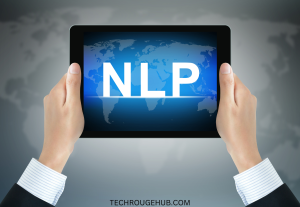Ever wondered how computers can understand us or learn from their experiences? These abilities come from Artificial Intelligence, Machine Learning, and Natural Language Processing (NLP). Though often mixed up, each field has its own special role in changing how we talk to machines.
Artificial Intelligence is a broad term for technologies that mimic human thinking. Machine Learning is a part of AI that lets machines get better with practice and data. NLP is all about making computers talk to us in our own language. Deep Learning adds another layer, using complex neural networks to handle huge amounts of data.
Exploring these technologies further, we’ll see how AI, Machine Learning, NLP, and Deep Learning work together. They’re changing our view of what it means for machines to be intelligent.

A high-tech cityscape at dusk, bathed in a warm, neon glow. In the foreground, a cluster of futuristic, interconnected structures represent the core components of artificial intelligence, machine learning, NLP, and deep learning. Intricate circuitry and undulating data streams flow between them, illuminating the complex interdependencies. In the middle ground, towering skyscrapers with sleek, angular facades symbolize the computational power and scalability of these technologies. The background is a hazy, dreamlike skyline, hinting at the boundless potential and endless possibilities of this rapidly evolving field. The overall scene conveys a sense of innovation, progress, and the seamless integration of human and machine intelligence.
Key Takeaways
- Artificial Intelligence covers a wide range of technologies that aim to mimic human intelligence.
- Machine Learning helps machines learn from data and get better over time.
- Natural Language Processing makes it possible for machines to understand and use human language.
- Deep Learning uses complex neural networks for advanced data processing.
- The connection between AI, Machine Learning, NLP, and Deep Learning is key for tech progress.
Understanding Artificial Intelligence
Artificial Intelligence (AI) is a big leap in technology. It makes machines think like humans. There are two main types: Narrow AI and General AI. Narrow AI does specific tasks, like Spotify’s recommendations. General AI can do anything a human can.
Cognitive AI is a part of AI that makes decisions better. It uses lots of data to find patterns and insights. This helps in many areas, like finance and healthcare.
AI is changing how we use technology. It makes learning personal in schools and helps find diseases fast in hospitals. It’s making our interactions with computers smarter and easier.
| Type of AI | Description | Examples |
|---|---|---|
| Narrow AI | Designed to perform a specific task. | Chatbots, Video Recommendations |
| General AI | AI that can perform any intellectual task. | Theoretical concepts, Future Developments |
| Cognitive AI | Enhances decision-making through machine data analysis. | Voice Assistants, Predictive Analytics |
What is Machine Learning?
Machine Learning is a key part of today’s tech world. It’s about creating algorithms that let systems learn from data. This way, machines can get better at certain tasks over time, even without being programmed directly. Knowing the different types of Machine Learning helps us see how it works and its uses in many fields.
Types of Machine Learning
There are three main types of Machine Learning: supervised, unsupervised, and reinforcement learning. Each type has its own special features:
- Supervised learning: This type uses labeled data. Models learn by making predictions from input-output pairs.
- Unsupervised learning: This type trains without labeled data. It looks for hidden patterns or structures in data.
- Reinforcement learning: This method teaches agents through trial and error. They learn to make decisions to reach specific goals.
Real-World Applications of Machine Learning
Machine Learning algorithms are used in many ways across different industries. Here are some examples:
- Recommendation engines: Online stores use Machine Learning to suggest products based on what users like and have bought before.
- Fraud detection systems: Banks and financial companies use Machine Learning to spot and prevent fraud.
- Personalized marketing strategies: Businesses use data to create marketing plans that fit each customer’s preferences, improving their experience.
Introduction to Natural Language Processing (NLP)

Natural Language Processing (NLP) is a field that lets machines understand and even create human language. It connects computer algorithms with the complexities of human talk. Tokenization is a key technique in NLP, breaking down text into words or phrases for easier analysis.
Part-of-speech tagging is another important part of NLP. It labels words as nouns, verbs, and more. This helps in understanding sentences better. Named entity recognition also plays a role, identifying people, organizations, and places in text.
Language models like GPT-3 and BERT show NLP’s advanced capabilities. They can create text that sounds like it was written by a human. This is useful for many things, from creating content to helping with coding.
Text-to-speech technology is key for making text accessible. It turns written words into spoken language. This helps people who can’t see and those who learn better by listening. Conversational agents also play a big role, helping with customer service and personal tasks.
In short, NLP uses many techniques to improve how humans and machines talk to each other. This makes AI advancements more meaningful and useful.
Deep Learning: An Advanced Technique
Deep Learning is a big step forward in Machine Learning. It uses neural networks with many layers to act like the human brain. This lets computers handle huge amounts of data, changing how we do things like image and speech recognition.
At the heart of Deep Learning are CNNs and RNNs. CNNs are great at finding patterns in pictures, perfect for facial recognition and medical images. RNNs work well with words and data that comes in a sequence, useful for understanding language and predicting trends.
Deep Learning has changed many areas in real life:
- Image Recognition: Systems can spot and sort out objects in pictures very well.
- Speech Recognition: Devices can now understand and write down what we say, making talking to them easier.
- Autonomous Vehicles: Cars can look at what’s around them and decide what to do next, all on their own.
Deep Learning keeps getting better, showing us what tech can do. By learning about neural networks, you can explore new ways to work with data.
The Relationship between Artificial Intelligence, NLP, Machine Learning
Artificial Intelligence, Machine Learning, and NLP are closely linked. They form the base of today’s tech progress. Artificial Intelligence covers both Machine Learning and NLP. This shows how these techs work together to make smarter systems.
Machine Learning uses algorithms to analyze data. This lets systems get better over time without being programmed. It’s key for AI and NLP to work well. NLP, on the other hand, helps machines understand and create human language.
The mix of these fields boosts AI’s power. It makes possible things like virtual assistants and tools that analyze feelings.
| Technology | Description | Interrelation |
|---|---|---|
| Artificial Intelligence | The overall simulation of human intelligence by machines. | Inclusive of both Machine Learning and NLP |
| Machine Learning | Algorithms designed for data analysis and pattern recognition. | Powers NLP through predictive modeling |
| NLP | The ability of machines to interpret, understand, and respond to human language. | Utilizes Machine Learning for improved language processing |
This teamwork between Artificial Intelligence, Machine Learning, and NLP opens up new possibilities. It lets systems understand and react to user input. By combining their strengths, businesses can make solutions that improve user experience on different platforms.
Key Components of Neural Networks
Neural networks have key parts that work together to process data well. Knowing these parts is key for those new to machine learning.
Layers are the core of neural networks, with each layer adding to the function. You’ll find input, hidden, and output layers. Each layer has nodes, or neurons, that do calculations. The connections between nodes have weights that change as the network learns.
Activation functions are important for what each neuron outputs. They make the network learn complex patterns. You’ll see Sigmoid, ReLU (Rectified Linear Unit), and Tanh used often. Each function affects the network’s performance in various ways.
| Component | Description | Example |
|---|---|---|
| Layers | Structurally define the neural network’s architecture | Input, Hidden, Output |
| Nodes | Individual units within layers performing calculations | Neurons firing based on inputs |
| Weights | Parameters that adjust based on training | Connection strengths between neurons |
| Activation Functions | Determine the output of nodes | Sigmoid, ReLU, Tanh |
Understanding these components helps you see how algorithms in neural networks work. This knowledge improves your understanding of machine learning.
Conversational Agents and Chatbots
Conversational agents and chatbots have changed how businesses talk to customers. They use Natural Language Processing to act like humans, making communication smooth and effective. With more automation, chatbots are key to better user interaction and easier customer service.
The Role of NLP in Chatbots
Natural Language Processing is vital for chatbots. It lets them understand and reply to human speech. This way, they can have real conversations, help with questions, and make transactions fast.
Many industries like retail, healthcare, and finance are using chatbots. They offer quick help, cutting down wait times and boosting happiness. NLP makes chatbot talks feel personal and right for each person.
As tech gets better, chatbots will get even smarter. They’ll handle more complex talks, becoming essential in many areas.
Emotion Management in AI Technologies
In today’s fast-changing digital world, managing emotions is key in AI. Machines now mimic human interactions better. They can read and react to emotions, making our interactions with them more enjoyable.
Many efforts are being made to add emotional smarts to AI. These systems can now understand and respond to our feelings. This makes our interactions with technology more personal and satisfying.
Emotion management is important in many areas. For example, in customer service, AI can sense how we feel and respond in a way that meets our needs. It also helps in mental health by recognizing mood changes and providing support.
As we move forward, investing in better emotion management in AI is vital. We’ll see machines that not only do tasks but also understand and respond to our emotions. This will lead to more harmonious and effective interactions.
Healthcare Applications of AI and Machine Learning
AI and Machine Learning are changing patient care and medical research. They are making a big difference in two main areas: helping with speech problems and finding Parkinson’s disease early. These advancements are improving patient lives and making healthcare more efficient.
Speech Restoration Technologies
Speech restoration uses Machine Learning to help people with speech issues. It looks at how people speak and gives feedback right away. This makes therapy more personal and effective, helping patients speak better.
Parkinson’s Disease Detection
AI is key in spotting Parkinson’s disease early. It looks at patient data and medical records to find symptoms quickly. Finding symptoms early is important for starting treatment and improving patient results. These tools help doctors give better care and watch patients more closely.
| Application | Description | Benefits |
|---|---|---|
| Speech Restoration | Utilizes Machine Learning to aid communication for speech-impaired individuals. | Personalized therapy leading to improved communication skills. |
| Parkinson’s Disease Detection | Employs AI for the early identification of Parkinson’s disease symptoms. | Timely intervention and improved patient care strategies. |
Exploring Sentiment Analysis
Sentiment analysis is a key part of text analytics, linked to natural language processing (NLP). It helps find the feelings behind text, giving a clear view of what people think. Companies use it to see how people feel about their brands and products on social media.
Finding out if news is true is very important today. Sentiment analysis helps spot fake news by looking at the emotions and context in what people write. This helps companies make better marketing plans and keep their customers happy.
When dealing with social media, sentiment analysis helps make sense of lots of data. It uses smart algorithms to check how people are interacting. This way, businesses can better understand what their customers want and solve problems quickly.
Algorithms Driving Modern AI Solutions
Algorithms are the core of today’s AI, helping with data handling and making decisions. Knowing about different algorithms helps us understand how AI works. For example, decision trees, support vector machines, and deep learning algorithms each play a special role in various fields.
Research keeps improving algorithms, making AI better. New techniques in deep learning use neural networks to handle big data. This has led to huge leaps in image and speech recognition.
Using algorithms well can change how we solve real-world problems. They help in areas like healthcare and finance. By using strong algorithms, AI can tackle new challenges, leading to ongoing improvement through research and testing.
| Algorithm Type | Characteristics | Common Applications |
|---|---|---|
| Decision Trees | Simple to understand, visual representation, easy to interpret. | Customer segmentation, fraud detection. |
| Support Vector Machines | Effective in high-dimensional spaces, robust against overfitting. | Image classification, bioinformatics. |
| Deep Learning Algorithms | Utilizes neural networks, excels with large datasets, able to extract features. | Natural language processing, autonomous vehicles. |
Conclusion
In this summary of AI, we’ve looked at how Artificial Intelligence, Machine Learning, and Natural Language Processing (NLP) work together. We’ve seen how these technologies have grown, becoming more important in many areas. They’ve moved from simple algorithms to complex neural networks, showing the ongoing progress in the digital world.
Looking ahead, AI and Machine Learning will change many things, not just in work but in our daily lives too. We’ll see better chatbots, smarter health apps, and new ways to understand feelings. Knowing about NLP helps us see the future of how we talk and interact with technology.
It’s important to keep up with AI and its parts as we move into the 21st century. These technologies will change how we work, talk, and solve problems. As they grow, they’ll help us tackle big challenges today. Let’s welcome the changes AI, Machine Learning, and NLP bring, making our world smarter and more connected.
FAQ
What is the difference between Artificial Intelligence, Machine Learning, and Natural Language Processing?
Artificial Intelligence (AI) is like a big umbrella that uses technology to act smart like humans. Machine Learning (ML) is a part of AI that uses math to help machines learn from data. Natural Language Processing (NLP) is another part of AI that deals with how computers talk to humans.
Deep Learning is a special way of doing Machine Learning. It uses lots of layers to understand data, like how our brains work.
What are the applications of Artificial Intelligence?
AI is used in many areas, like finance, healthcare, and education. In healthcare, AI helps doctors diagnose and plan treatments. In finance, it spots fraud and makes customer service better.
These uses make computers easier to talk to, making our lives better.
How does Machine Learning work?
Machine Learning uses different ways to learn, like supervised, unsupervised, and reinforcement learning. Supervised learning uses labeled data to teach machines. Unsupervised learning finds patterns in data without labels.
Reinforcement learning lets machines try things and learn from feedback.
What are the key techniques used in Natural Language Processing?
NLP uses techniques like breaking down text into words and figuring out what each word means. It also finds important words in text. These help machines understand and use human language.
This is how chatbots and text-to-speech work.
What is Deep Learning and how is it different from Machine Learning?
Deep Learning is a part of Machine Learning that uses lots of layers to understand data. Unlike simple Machine Learning, Deep Learning is great at handling lots of data, like images and speech.
How are AI, Machine Learning, and NLP interconnected?
AI is the big picture that includes Machine Learning and NLP. Together, they make things like smart customer support and self-learning systems possible.
What are neural networks and why are they important?
Neural networks are like the brain of computers. They have lots of nodes that work together to understand data. This is why they’re good at things like recognizing images and translating languages.
What role do chatbots play in modern business?
Chatbots use NLP to help with customer service. They answer questions and help with problems, making businesses more efficient and customer-friendly.
How does emotion management work in AI?
AI can understand and respond to human emotions. This makes interactions with technology more personal and friendly. It’s all about making technology more human-like.
How is AI benefiting healthcare?
AI is changing healthcare by helping with speech problems and finding diseases early. It helps doctors keep an eye on patients and act fast when needed.
What is sentiment analysis and its significance?
Sentiment analysis is about understanding what people think from text. It’s used to see what people really think about things. Companies use it to make their products better and happier customers.
What types of algorithms are used in modern AI solutions?
AI uses many algorithms, like decision trees and deep learning. These algorithms help AI solve big problems and get better over time.

